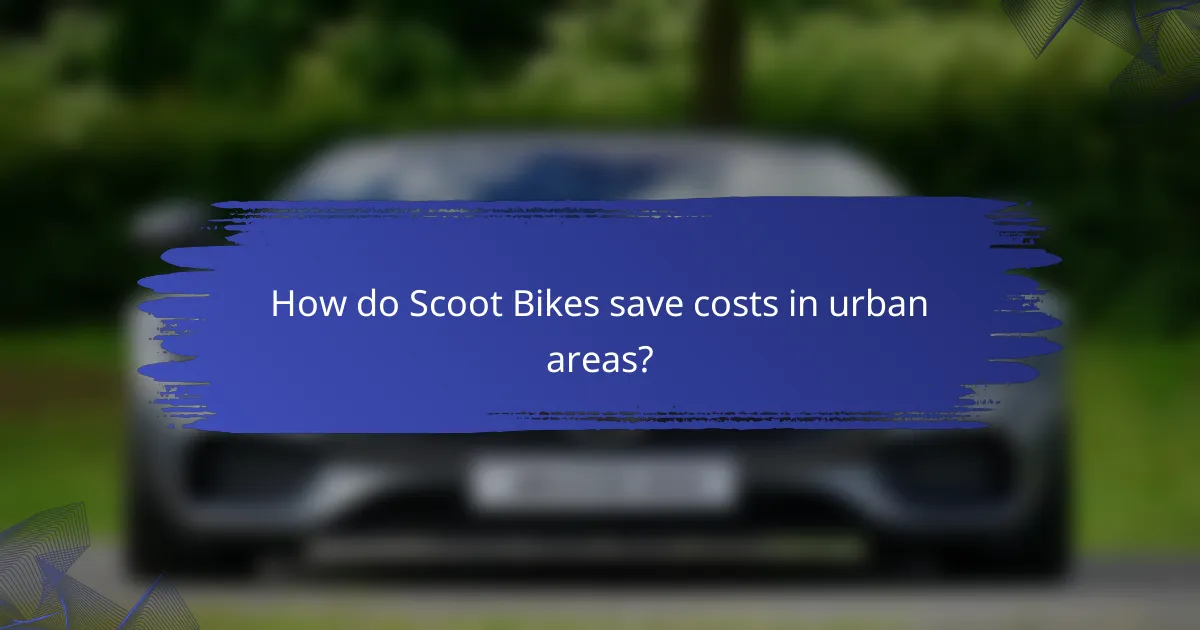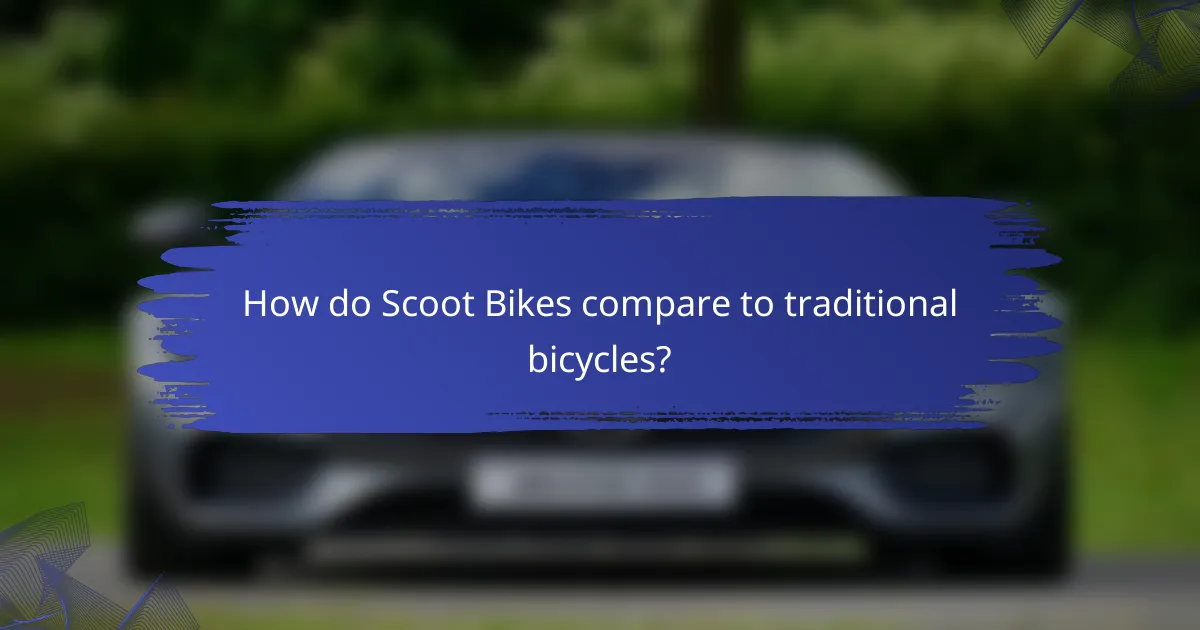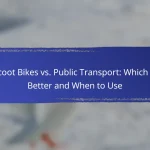Scoot bikes present an economical solution for urban commuting by cutting down on fuel expenses, parking fees, and maintenance costs. Their ability to navigate through traffic efficiently and offer flexible routing makes them an ideal choice for those seeking to enhance their daily travel experience. Regular maintenance, including tire checks and battery upkeep, ensures these bikes remain safe and reliable for everyday use.

How do Scoot Bikes save costs in urban areas?
Scoot bikes significantly reduce costs in urban areas by minimizing fuel expenses, lowering parking fees, and decreasing maintenance costs. These savings make them an attractive option for commuters looking to navigate city environments more economically.
Lower fuel expenses
Scoot bikes operate on electricity, which is generally cheaper than gasoline. Depending on local electricity rates, charging a scoot bike can cost just a few cents per charge, compared to several dollars for filling a gas tank. This translates to substantial savings for daily commuters.
Additionally, electric bikes often have a much higher energy efficiency compared to traditional vehicles, allowing users to travel further on less energy. This efficiency can lead to savings of up to 80% in fuel costs over time.
Reduced parking fees
Parking costs in urban areas can be significant, often ranging from a few dollars to over twenty dollars per day. Scoot bikes typically require much less space and can be parked in designated bike racks or even on sidewalks, which often have no associated fees.
By avoiding parking garages and meters, scoot bike users can save hundreds of dollars annually. Many cities also offer incentives or free parking for electric bikes, further enhancing the cost benefits.
Maintenance savings
Maintenance for scoot bikes is generally lower than for traditional vehicles. Electric bikes have fewer moving parts, which means less wear and tear and lower repair costs. Routine maintenance can often be limited to tire checks and brake adjustments.
Users can expect to spend significantly less on maintenance, typically around 50-70% less than what car owners might pay annually. This makes scoot bikes a more economical choice for urban commuting.

What are the commuting efficiency benefits of Scoot Bikes?
Scoot bikes offer significant commuting efficiency benefits by enabling faster travel times, reducing traffic congestion, and providing flexible routing options. These advantages make them an appealing choice for urban commuters looking to optimize their daily travel.
Faster travel times
Scoot bikes can dramatically decrease travel times compared to traditional commuting methods. In many urban areas, riding a scoot bike can save several minutes on short trips, allowing you to reach your destination more quickly. This is particularly beneficial during peak hours when car traffic is heavy.
For example, a trip that might take 30 minutes by car during rush hour could be completed in under 15 minutes on a scoot bike. This efficiency can lead to more productive use of your time, whether for work or leisure.
Less traffic congestion
Using scoot bikes contributes to reduced traffic congestion in urban settings. As more commuters opt for bikes instead of cars, the overall number of vehicles on the road decreases, leading to smoother traffic flow. This not only benefits bike riders but also helps drivers by alleviating some of the gridlock.
In cities where bike lanes are available, scoot bikes can navigate through traffic more easily, further minimizing congestion. This shift can lead to a more pleasant commuting experience for everyone on the road.
Flexible routing options
Scoot bikes provide the advantage of flexible routing, allowing riders to choose paths that may not be accessible to cars. This flexibility enables commuters to avoid traffic jams and take shortcuts through parks or bike paths, enhancing their overall travel experience.
Additionally, riders can adapt their routes based on real-time conditions, such as detours or road closures, making scoot bikes a versatile option for daily commuting. This adaptability can lead to more efficient travel and a greater sense of control over one’s journey.

What maintenance is required for Scoot Bikes?
Maintaining Scoot Bikes involves regular checks and servicing to ensure optimal performance and safety. Key maintenance tasks include tire inspections, battery upkeep, and brake evaluations.
Regular tire checks
Regular tire checks are essential for safe riding and efficiency. Inspect the tire pressure at least once a month, ensuring it falls within the manufacturer’s recommended range, typically around 30-50 PSI.
Look for signs of wear, such as cracks or uneven tread. Replace tires that show significant damage to prevent accidents and maintain smooth handling.
Battery maintenance
Battery maintenance is crucial for the longevity of Scoot Bikes. Charge the battery regularly, ideally after each use, and avoid letting it completely discharge, as this can shorten its lifespan.
Keep the battery terminals clean and free of corrosion. If the bike is not used for an extended period, store it with a partially charged battery to maintain health.
Brake inspections
Brake inspections should be conducted frequently to ensure safety. Check the brake pads for wear and replace them if they are less than 3 mm thick.
Test the brakes regularly to ensure they engage smoothly and effectively. If you notice any unusual noises or reduced braking power, have them serviced immediately to avoid potential hazards.

What factors should be considered when choosing a Scoot Bike?
When selecting a Scoot Bike, important factors include battery life, weight capacity, and brand reputation. Each of these elements can significantly impact your commuting experience and overall satisfaction with the bike.
Battery life
Battery life is crucial for ensuring that your Scoot Bike can handle your daily commuting needs without frequent recharging. Most electric scooters offer a range of 15 to 40 miles on a single charge, depending on the model and riding conditions.
Consider your typical travel distance when evaluating battery life. If you have a longer commute, opt for a bike with a higher capacity battery to avoid running out of power mid-journey. Additionally, check the charging time, as some models can recharge in just a few hours while others may take longer.
Weight capacity
Weight capacity is an essential factor to consider, as it determines how much load your Scoot Bike can safely carry. Most scooters can support riders weighing between 100 to 300 pounds, but it’s important to verify the specifications of each model.
Exceeding the weight limit can affect performance and safety, leading to reduced speed and stability. If you plan to carry additional items, such as a backpack or groceries, ensure that the total weight remains within the bike’s capacity.
Brand reputation
Brand reputation plays a significant role in the reliability and quality of your Scoot Bike. Established brands often have a history of producing durable and efficient models, which can provide peace of mind when making a purchase.
Research customer reviews and ratings to gauge the experiences of other riders. Look for brands that offer good customer support and warranty options, as this can be beneficial if you encounter any issues with your bike.

How do Scoot Bikes compare to traditional bicycles?
Scoot bikes offer a unique blend of speed and convenience compared to traditional bicycles. While both serve as effective means of transportation, scoot bikes typically provide a more efficient commuting experience due to their design and technology.
Speed advantages
Scoot bikes are generally faster than traditional bicycles, often reaching speeds of up to 28 km/h (about 17 mph) or more, depending on the model and conditions. This speed can significantly reduce commute times, especially in urban areas where traffic congestion is common.
Additionally, scoot bikes can accelerate quickly, allowing riders to navigate through city streets more efficiently. This advantage is particularly noticeable during short trips, where traditional bicycles may struggle to maintain a competitive pace.
Cost differences
The initial cost of scoot bikes can be higher than that of traditional bicycles, often ranging from a few hundred to several thousand USD, depending on features and brand. However, when considering long-term expenses, scoot bikes may offer savings through reduced maintenance and fuel costs.
Traditional bicycles typically require regular upkeep, including tire replacements and brake adjustments, which can add up over time. In contrast, scoot bikes, particularly electric models, often have lower maintenance needs, making them a cost-effective choice for daily commuting.









